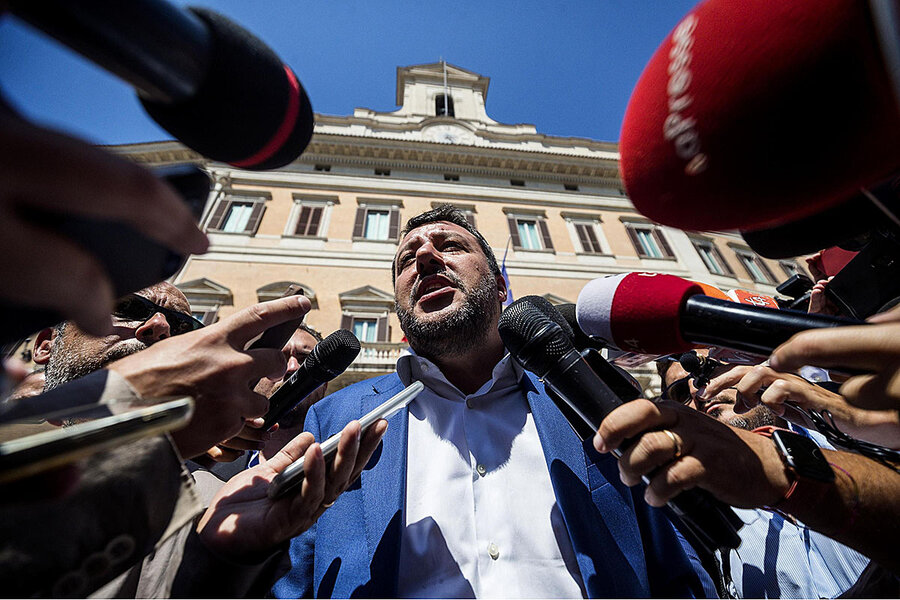Political turmoil in Italy as far-right reaches for the reins
Loading...
| Basel, Switzerland
Italy is in political disarray after Italian Prime Minister Giuseppe Conte resigned Tuesday, effectively putting an end to its 14-month-old ruling coalition of right-wing and left-wing populists.
But the more significant effect of Mr. Conte’s move might have been to prevent – or at least forestall – the election of the most right-wing government in Italy since that of Benito Mussolini.
Now Italian President Sergio Mattarella is exploring the options for a new coalition. If he is successful, it could leave Matteo Salvini, the highly popular, ambitious far-right interior minister and leader of the right-wing League party, out in the cold.
Why We Wrote This
Italian governments are notorious for having short, volatile lifespans. But the latest collapse Tuesday has important implications about just how far to the right Italy’s leadership may be about to swing.
What triggered the current political crisis? Why now?
The current political crisis is the culmination of long-simmering tensions between the anti-establishment Five Star Movement (M5S), currently the largest faction in Parliament, and Mr. Salvini’s League, which went from 6.2% in the 2014 European ballot to Italy’s largest party in 2019.
The two euroskeptic parties banded together in a governing coalition in June 2018 but were never natural allies. They were united in their promise to lift Italians out of poverty and their reticence to embrace even the most basic of European Union austerity measures. In power, they squabbled over purse strings and pet issues, giving Brussels a headache.
The League is one of the brightest stars in the constellation of far-right nationalist parties that are gaining momentum in Europe. Mr. Salvini is particularly popular in northern Italy and has become the poster boy of European populists. He is pro-family, anti-immigrant, and euroskeptic.
The political crisis is primarily the outcome of Mr. Salvini’s calculus that triggering snap elections would play out in his favor. He shocked the nation by calling for a no-confidence vote on Aug. 9 when much of Italy was still at the beach; his summer appearances along the Italian coast suggested a man in campaign mode.
“Mr. Salvini is trying to force a snap election in order to capitalize on the League’s surge in electoral support since the 2018 general election,” notes Agnese Ortolani, Europe research analyst at The Economist Intelligence Unit. “A right-wing coalition led by Mr. Salvini could secure up to two-thirds of the seats in parliament ... the biggest parliamentary majority in the history of the Italian Republic and one that would allow him to change the constitution.”
What happens next?
Wednesday opened what promises to be a volatile period rife with dealmaking and volte-face. “We are in a 50-50 situation,” says Lorenzo Castellani, a politics professor at Rome’s Luiss University. “Fifty percent, we could have snap elections, or we could have a new majority.”
The first scenario entails holding fresh elections in late October – Mr. Salvini’s wish. Opinion polls suggest that the League would win by a wide margin. This could mean solo rule by the nationalist party or a dominant position in a right-wing governing coalition including Forza Italia – the party of former Prime Minister Silvio Berlusconi – and the ultranationalist Brothers of Italy party.
Another scenario is that an alternative government is found. While Mr. Salvini’s League is popular among the public, the distribution of power in Italy’s legislature is not a mirror of Italian society at this moment. In the legislature, the League holds just 17% of the seats. Fear of performing poorly in near-term elections could be strong enough incentive for the larger parties in Parliament to set aside their differences and dial back the crisis.
This could spur an alliance between M5S and the opposition, center-left Democratic Party. Less likely, but not impossible, is that the existing M5S-League coalition is salvaged. Yet another possibility – though only likely in the case of an impasse – is that the president decides to form a technocratic government to deal with the 2020 budget and push forward key policy decisions.
What are Mr. Salvini’s chances of coming to power?
The capacity of M5S and Democrats to work together was evidenced when they blocked Mr. Salvini’s calls for an immediate no-confidence vote. That may be sufficient to keep him from higher office, as his alternatives are limited.
“The League only has one option basically, which is snap elections as soon as possible. In the other case, it is very difficult that another majority which includes the League will come up,” says Professor Castellani. “Salvini has made a sort of ‘all in’ on his political career calling for snap elections.”
If snap elections aren’t held, the League would be relegated to opposition status. There is also a long-shot possibility that Mr. Salvini could pull together a League-led right-wing coalition within the current Parliament.
What does the political crisis mean for Italy and Europe?
The timing couldn’t be worse for Italy, where the legislature is scheduled to be formulating the 2020 budget rather than putting out political fires. Snap elections would force the Italian legislature to hammer out next year’s budget on an accelerated timeline – within a few weeks rather than over a couple of months.
Under pressure from the European Commission and confronted with the growing risk of a 2020 recession, Italy has committed to a major increase in the value-added tax if it cannot bring its budget deficit under control through other means.
But were the League to win snap elections and Mr. Salvini to become prime minister, that would undoubtedly put Europe and Italy on a collision course. Mr. Salvini has promised voters sweeping tax cuts, and he has been at loggerheads with Brussels after he banned the disembarkation of migrants rescued at sea in Italian ports.






